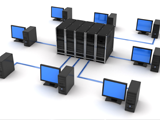IMDEA Networks

Event Category: External Presentation (External Speaker)
A Virtual Laboratory for Distributed Systems Research Examples in Research (MAKI) and Teaching
Networking research and development is an important field in information technology and its importance grows with the rise of the Internet and the ubiquity of worldwide communication.
Read more arrow_right_altQuantifying Information Overload in Social Media and its Impact on Social Contagions
Information overload has become an ubiquitous problem in modern society. Social media users and microbloggers receive an endless flow of information, often at a rate far higher than their cognitive abilities to process the information.
Read more arrow_right_altTransport Services - Internet Transport's Last Chance?
The Internet's Transport Layer has been defined by TCP and UDP for the last 30 years. The minimal functionality of UDP enables application developers to develop their own proprietary protocols - there are plenty of examples.
Read more arrow_right_altInferring Coarse Views of Connectivity in Very Large Graphs
This paper presents a simple framework, called WalkAbout, to infer a coarse view of connectivity in very large graphs; that is, identify well-connected “regions" with different edge densities and determine the corresponding inter- and intra- region connectivity.
Read more arrow_right_altFrom Quality of Service to Chaos in wireless networks
With the increasing availability of configurable network equipments, the research has moved from proposals to improve quality of service in the wireless standards, to complete potential chaos when it becomes accessible to every user. In this talk we go through this evolution and discuss its impact on the network and on the user.
Read more arrow_right_altNetwork Virtualization: Vision, Algorithms, Prototype
Virtualization is a powerful paradigm in computer science, as it allows to decouple software and services from the constraints of the underlying physical infrastructure. Virtualization is also one of the main innovation motors in today's Internet
Read more arrow_right_altHarnessing Visible Light for Time Synchronization and Mobile Context Recognition
Visible light is ubiquitous in the cyber-space nowadays. In this talk, I will introduce our recent work about how to harness visible light for mobile computing applications in both temporal and spatial design domains. Our work leverages the fact that the fluorescent light intensity changes with a stable period, which can serve as both a global time reference and an indoor environment indicator.
Read more arrow_right_altPublish/Subscribe for Large-Scale Social Interaction: Design, Analysis and Resource Provisioning
Publish/subscribe (pub/sub) is a popular communication paradigm in the design of large-scale distributed systems. We are witnessing an increasingly widespread use of the pub/sub for wide array of applications both in industry and academia and yet there is a lack of detailed study of a large-scale real-world pub/sub system.
Read more arrow_right_altUtility Optimization for Multi-Transmitter Wireless Data Systems
We study algorithms for carrier and rate allocation in cellular systems with distributed components such as a heterogeneous LTE system with macrocells and femtocells. Existing work on LTE systems often involves centralized techniques or requires significant signaling, and is therefore not always applicable in the presence of femtocells. More distributed CSMA-based algorithms (carrier-sense multiple access) were developed in the context of 802.11 systems and have been proven to be utility optimal. However, the proof typically assumes a single transmission rate on each carrier. Further, it relies on the CSMA collision detection mechanisms to know whether a transmission is feasible. In this talk we present a framework for LTE scheduling that is based on CSMA techniques. In particular we first prove that CSMA-based algorithms can be generalized to handle multiple transmission rates in a multi-carrier setting while maintaining utility optimality. We then show how such an algorithm can be implemented in a heterogeneous LTE system where the existing Channel Quality Indication (CQI) mechanism is used to decide transmission feasibility.
Read more arrow_right_altBitcoin. The TCP/IP of finances?
Bitcoin is a decentralized peer-to-peer payments network. It is the first and most widely used example of a new kind of money known as cryptocurrency. Transactions are fast, non-repudiable and almost anonymous. Fees are extremely cheap and every single transaction is stored in a ledger called the block chain.
Read more arrow_right_alt











Recent Comments